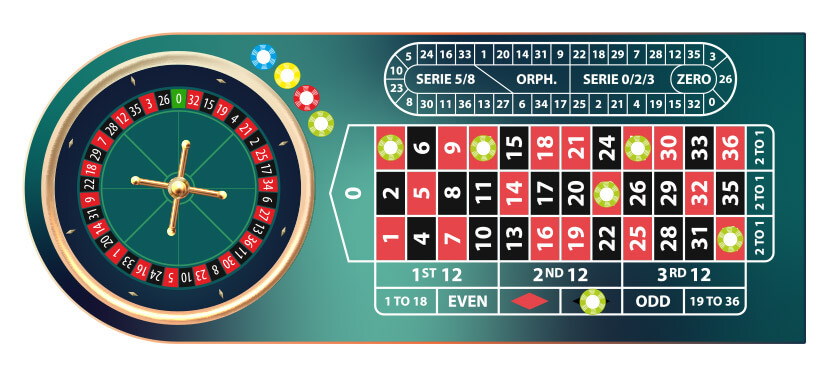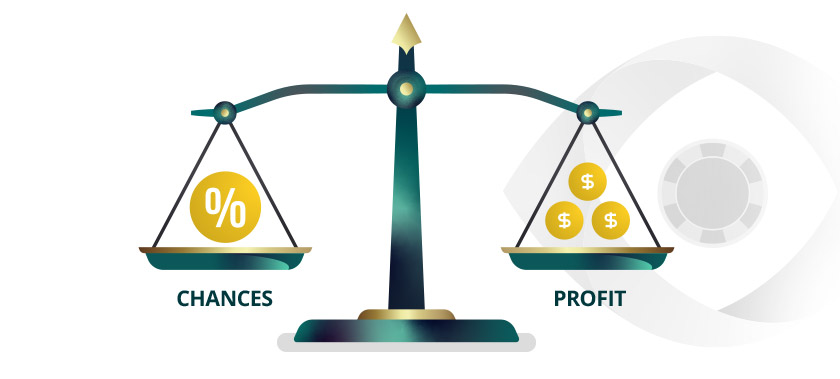Large-Coverage Roulette Bets – “Loading” the Table Efficiently

A frequent but rarely analyzed strategy for static betting in roulette is to use bets of a large coverage. It is the “safety” strategy, based on the principle that the larger the coverage of a bet, the higher its probability of winning. It is somehow the correspondent of the sport-betting strategy by which one bets on the victory of the better-ranked teams in one or several matches. However, a high likelihood of winning is counterbalanced by either a low profit rate in the case of a win or a high loss in the case of a loss, as we shall see further.
The Premises of Placing Large-Coverage Roulette Bets
There are two aspects of setting up a large-coverage roulette bet. One is the mathematical aspect. For you to choose among the various types of such bets, it is important to know in advance the mathematical parameters of each bet, particularly what your chances are and what your expectations should be for the chosen bet.
The other is the technical aspect. First, you have to use the particular configuration of the table for your placements since, as you know, the roulette numbers are arranged differently on the table than on the wheel, and the placement of bets must use the table design as a rule; as such, you may not cover with one placement some certain desired numbers.
Second, if you plan to use many placements at once, you must consider that the time before two spins is limited and that it might not be sufficient for you to place all the chips on the table.
Obviously, achieving a large coverage assumes using combined bets as running a simple bet will only provide a coverage of, at most, 18 numbers (for the outside bets—color, high/low, or even/odd). Having one of these outside bets in your combined bet is an advantage in not only what concerns the length of their coverage but also the contribution to the speed of placement with regard to the technical aspect of time mentioned above.
Setting up a multiple placement should also take into account non-contradictory betting (falling within the mathematical aspects of the bet) as well as the principle of not overlapping the coverages—since a high probability of winning stands as the main criterion of choosing a large-coverage bet, the placements should be mutually exclusive.
Choosing the Parameters of a Large-Coverage Bet
You may choose among the categories of bets and also among particular bets within the same category. Let us take as an example a large-coverage bet consisting of a color bet and several straight-up bets on numbers of the opposite color. Of course, its coverage can be enlarged with the number of the straight-up bets, which is one of its parameters; other parameters refer to the stakes of these simple bets. For simplicity, assume that the straight-up bets have the same stake, and as such, there is only one parameter left—the ratio between the stake of the color bet and the stake of a straight-up bet.

For generality and precision, denote by n the number of straight-up bets and by c that ratio. Denote by S the stake of a straight-up bet (then cS is the stake of the color bet). Let’s stay in the case of American roulette.
The possible events after the spin are as follows: A = winning the bet on color, B = winning a bet on a number, and C = not winning any bet. Their probabilities are summed into 1 since the events are mutually exclusive and exhaustive.
The probability of A is P(A) = 18/38 = 47.368%. In the case of winning the color bet, the player’s profit is cS − nS = (c − n)S (which can also be negative—that is, a loss).
The probability of B is P(B) = n/38. In the case of winning a straight-up bet, the player’s profit is 35S − (n − 1)S − cS = (36 − n − c)S.
The probability of C is P(C) = 1 − P(A) − P(B) = 1 − 9/19 − n/38 = (20 − n)/38. In the case of not winning any bet, the player loses cS + nS = (c + n)S.
The overall winning probability is P(A) + P(B) = (18 + n)/38.
What do these formulas tell us? First, the higher the value of n, the higher the winning probability, which was expected. Second, if n increases, so does the possible loss in case event C happens. This means that the “safety” given by a high winning probability is decompensated by the possibility of losing a large amount if no number in your coverage is hit.
Another factor may contribute to this decompensation: a possible low profit in the case of winning the color bet. For instance, choosing n = 10, c = 11, and S = 1$ (11 straight-up bets with a stake of 1$ each and an 11$ stake on the color bet), we have a 72.67% winning probability, a possible loss of 21$ if we do not win any bet, and only 1$ profit in case of winning the color bet; this means a very low profit rate relative to the investment (4.76%), along with the risk of a high loss.
How to Manage These Parameters to Suit Your Personal Strategy
First of all, it is natural to put the condition of a positive profit in both cases A and B, which results in n < c < 36 − n. This is a relation between parameters n and c that is also sufficient for the bet not to be contradictory and restrains the number of choices. Players who choose high “safety” (probability of winning) may opt for large n, up to 17, with c such chosen to enlarge either the possible profit in case of winning the color bet or the profit in case of winning a straight-up bet; in either option, a possible loss might cancel the low profits accumulated.
Players who do not want to wait for several small profits and prefer to chase isolated higher profits with a “decent” probability may choose lower values for n, with the cost of a higher probability of losing all bets (case C). For instance, n = 5 and c = 19 gives a possible profit of 14S (the color bet) or 12S (a straight-up bet) as well as a probability of losing all of almost 40%. This means a profit rate of about 50% in case of a win, with a probability of about 60%. Compared with the profit rate of a single outside bet with the same stake, it is about half lower; however, the winning probability increases for the combined bet by about 13%.
Whatever the choice for the parameters of such a bet, the three indicators—the probability of winning/losing, possible profit, and possible loss—are balanced relative to one another: as one increases, another decreases. This is explicable through the expected value of the bet, which is constant relative to the stake: EV = [−(c + n)/19]S, for a total stake of (c + n)S; this means −1/19 (that is, −5.263%) as a percentage of the stake.
This number stands as the EV for any simple or complex bet in American roulette and also gives its house edge: HE = 5.263%. Over the long run, you are expected to lose, on average, 5.263 cents at every dollar bet, whatever your choice for parameters n and c. Of course, a high enough probability of winning (achievable through high values of n) is likely to manifest in practice through constant winnings over the short to medium run, with its associated disadvantages that I mentioned above.

This general rule of balancing is, in fact, a gambling law applicable to any bet in any game of chance: any parameter advantageous for the player is counterbalanced by a disadvantageous one, for the expected value of the bet is constant.
Other Categories of Large-Coverage Bets
Using the equivalence of bets, we may choose other categories of large-coverage bets having the same parameters as that in our example above (red/black bet and straight-up bets on numbers of opposite color). These are a high/low bet and straight-up bets on low/high numbers and an even/odd bet and straight-up bets on odd/even numbers, respectively, provided that they have the same stakes. We may also combine the color bet with split bets instead of straight-up bets of the opposite color (there are seven such splits).
We may also enlarge the coverage of the simple bets through other categories of combined bets such as the following:
- 1. A column bet and straight-up bets on numbers outside that column
- 2. Street bets with predominant color and a color bet on the opposite of the predominant color (this complex bet is derived from the observation that each street contains two numbers of the same color; from all twelve streets, six contain two red numbers each and the other two black numbers each)
- 3. Line bets with predominant color and a color bet on the opposite of the predominant color (this complex bet is derived from the observation that some lines contain four black numbers and two red numbers each; then we combine the bets on these lines with a bet on color red to enlarge the coverage)
[Equivalent bets for types (3) or (4) are obtained by switching color to even/odd.]
- 4. Corner bets with predominant color and a color bet on the opposite of the predominant color (this complex bet is derived from the observation that some corners join three black numbers and one red number each)
- 5. Bets on the first and third columns and on the color black (this complex bet is derived from the observation that the first and third columns contain the most red numbers—the first column has six red numbers, and the third column has eight, while the second column has only four)
Of course, the bets falling within either category from (1) to (5) have different parameters than the bet discussed as an example in the previous section, and they differ from one another. They are not the only categories of large-coverage bets; others may be set up as well from mutually exclusive bets.
The bets of categories (2), (3), (4), and (5) speculate some asymmetries of the configuration of the table with regard to the characteristics of the numbers (color, evenness, etc.). Such speculation does not influence the house edge, which remains constant in the game of roulette, but just helps in organizing our large-coverage bets efficiently.





Review this Blog
Leave a Comment
User Comments
comments for Large-Coverage Roulette Bets – “Loading” the Table Efficiently